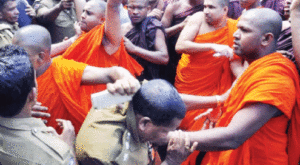
By Nursheila Muez and Jessica Yeo Jia Lin*
A recent road accident involving a Sinhalese truck driver and four Muslim men in Kandy district, Sri Lanka quickly spiralled into violent conflict after news that the driver died of his injuries days later. Attacks by mobs on Muslim homes and properties prompted the Sri Lankan government to declare a state of emergency.
This recent spate of anti-Muslim attacks in Sri Lanka is neither new nor random. Anti-Muslim sentiments have risen in the country due to the spread of ultranationalist Buddhist rhetoric, similar to one seen in Myanmar recently. One of the key extremist groups in Sri Lanka responsible for such rhetoric is the Bodu Bala Sena (BBS).
Justifying Buddhist Violence
Formed in 2012, the BBS has been actively defending Sinhalese Buddhism by stoking fears of the perceived threats from other religious communities. It largely targets the Tamil-speaking Muslim community, but has also included the Christians in its ultranationalist Buddhist rhetoric.
Rumours that Muslims would outnumber the Sinhalese Buddhists and the belief that the minority was economically superior are often circulated online, causing fear and distrust among the Sinhalese Buddhist majority that they will be displaced through a Muslim “take over”. The BBS has also capitalised on the rise of global Islamist terrorism to demonise the Muslims. Aside from spreading fake news and stoking fear, it has also turned to resources within Buddhism to justify its violent actions.
A popular historical and religious resource often used is the Mahavamsa, a post-canonical epic poem that recounts the miraculous visit of Buddha to Sri Lanka. It focuses on the actions of Buddha, King Dutugemunu and King Ashoka. Many ultranationalist Buddhists have argued that the passages in the Mahavamsa permits dharma yuddhaya (the defence of the dharma, which is the eternal law and order of the cosmos, or just war) and the text has been used since Sri Lanka’s colonial days.
A portion of the infamous canon details King Dutugemunu’s conversation with the arahants (the living representations of the dharma). Here, the arahants told the King that he should not feel troubled even though he had killed over 60,000 men. To the arahants, war in Buddhism is justified if the violence contained a moral aspect.
They saw King Dutugemunu as one who was protecting the dharma and noted that no harm was done as the opposing army was attacking their belief. To the arahants, the lives of the 60,000 men was only equivalent to the lives of one and a half human beings. This same passage was also used by one of Myanmar’s monastic leaders Sitagu Syadaw in November 2017 to legitimise the Tatmadaw’s violence against the Rohingya population.
Another popular mention in the Mahavamsa is King Ashoka. Some believe that his act of war helped to spread Buddhism to the conquered population; a view that some hold in high regard. Yet another Buddhist text to note is the Cakkavatti Sihanada Sutta. Even though it is not cited as often as the Mahavamsa, some ultranationalist Buddhists believe the text states that violence can be justified in Buddhism if it is used as a defensive measure.
‘Ambivalence of the Sacred’
This does not at all suggest that Buddhism inherently promotes violence. It is also not to debate whether Buddhists are violent or benevolent people. Rather, the point is to acknowledge and accept that Buddhists who embrace the ultra-nationalist orientation – just like other extremist religious adherents be they Muslims, Christians, or others – are people who experience a spectrum of emotions, including fear, suffering, anger and violence. They may, as a result resort to their religious traditions to seek justification for their situation.
Religious scholar Scott Appleby highlighted the ambivalent nature of the sacred. He posits that there is nothing inherently violent or peaceful about a religious tradition; how a religion manifests itself as violent or peaceful is largely dependent on how its adherents interpret the different resources available within the tradition. This is why terrorists and peacemakers can exist in the same community and adhere to the same religion.
Appleby argues that religion’s ability to incite violence is intimately related to its equally impressive power as a force for peace. It is therefore crucial that the focus shifts to the positive resources within the religion in order to provide a compelling counter-narrative to the exclusivist and ultranationalist rhetoric spouted by groups like BBS.
Way Forward
In this context, other organisations and civil society groups which adopt moderate and humanistic teachings of Buddhism can lead the way in disseminating positive messages. A number of Sinhalese Buddhist leaders in fact have already denounced the ongoing riots, but this move needs to be supplemented with a more long-term strategy of promoting resources for peace in the country.
Additionally, beyond promoting a positive counter-narrative, it is also crucial that ultranationalist Buddhist groups re-think their attitude towards moderate Buddhist institutions, minority religious groups as well as the state in Sri Lanka. For the country to move forward, all these institutions need to work closely together in its peacebuilding process.
*Nursheila Muez is a Research Analyst and Jessica Yeo Jia Lin is a Student Research Assistant in the Studies of Inter-Religious Relations in Plural Societies (SRP) Programme at the S. Rajaratnam School of International Studies (RSIS), Nanyang Technological University, Singapore.

In fact the Mahavamsa is a myth just written to please the Sinhalese masses. There is no actual proof to show that Lord Buddha visited Sri Lanka. The curse for the country is the mindset of Mahavamsa and the country is in ruins and is now considered as a rouge country where there is no rule of law and justice. The following links will prove this fact
https://www.colombotelegraph.com/index.php/the-inherent-concept-of-sinhala-buddhist-domination-in-sri-lanka/
GENOCIDE OF TAMILS IN SRI LANKA
https://www.academia.edu/29486541/Importance_of_an_Independent_Homeland_for_Tamils_in_Sri_Lanka_Genocide_of_Tamils_in_Sri_Lanka
https://www.academia.edu/30862240/UN_SYSTEM_OWES_SRI_LANKAN_TAMILS_REMEDIAL_JUSTICE
https://www.academia.edu/35758516/Continuing_Sufferings_and_Protests_of_Tamils_in_the_North_and_East_of_Sri_Lanka_demanding_Justice
MOUNTING JUSTIFICATION FOR TAMILS TO RESORT TO SELF-DETERMINATION AND RFERENDUM
https://www.academia.edu/35415017/MOUNTING_JUSTIFICATION_FOR_TAMILS_TO_RESORT_TO_SELF-DETERMINATION_AND_RFERENDUM
https://www.academia.edu/34151481/SRI_LANKAS_CREDIBILITY_AND_UNS_RESPONSIBILITIES
https://www.academia.edu/34202740/SRI_LANKAS_GENOCIDE_OF_TAMILS
https://www.academia.edu/28419263/chemical_weapons_used_to_wipe_out_the_Tamils_in_Sri_Lanka
SRI LANKA’S HIDDEN GAME PLAN – PLIGHT OFOPPRESSED TAMILS DEMANDING JUSTICE
https://www.academia.edu/34285835/indictment_against_SL.docx